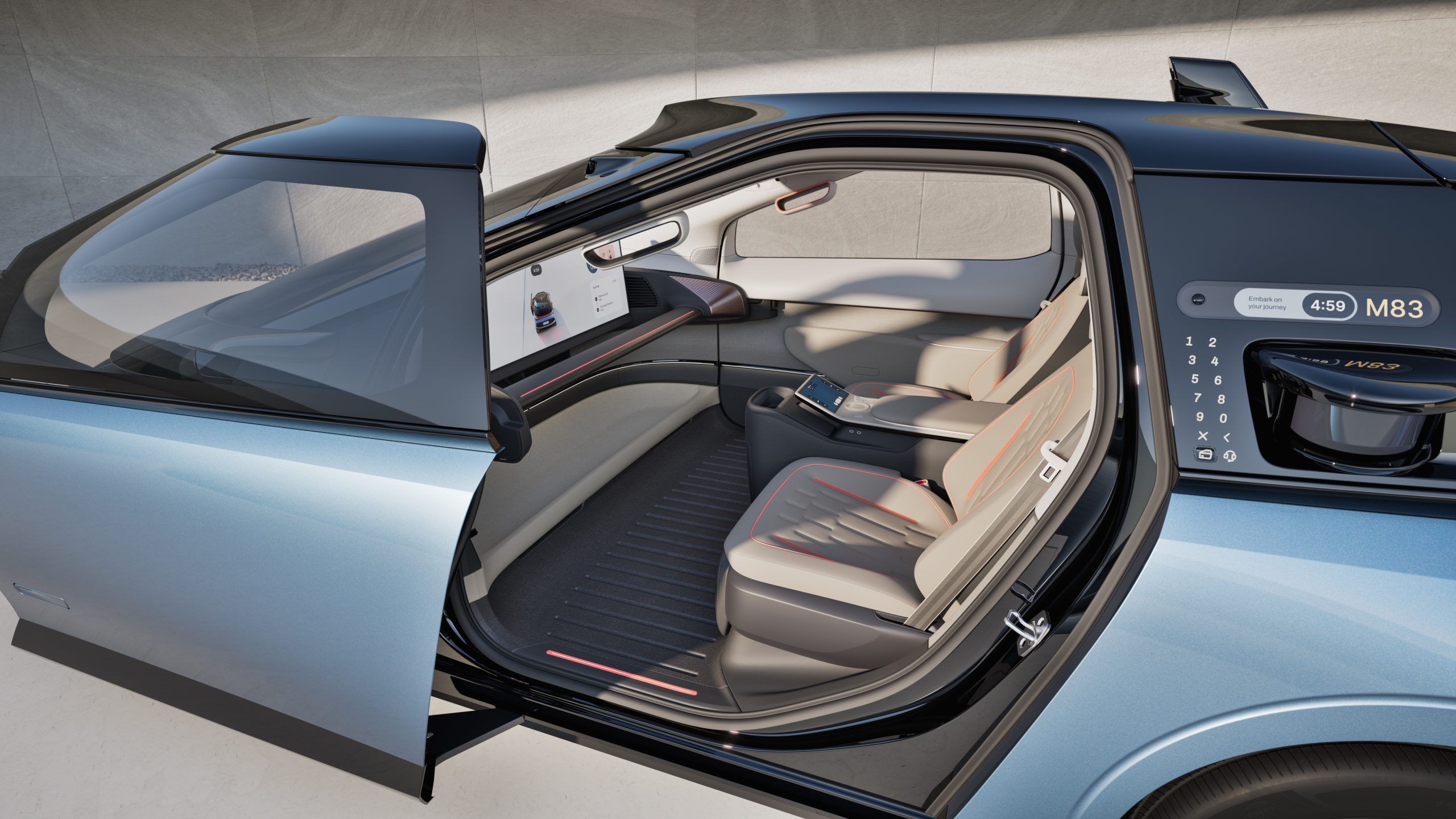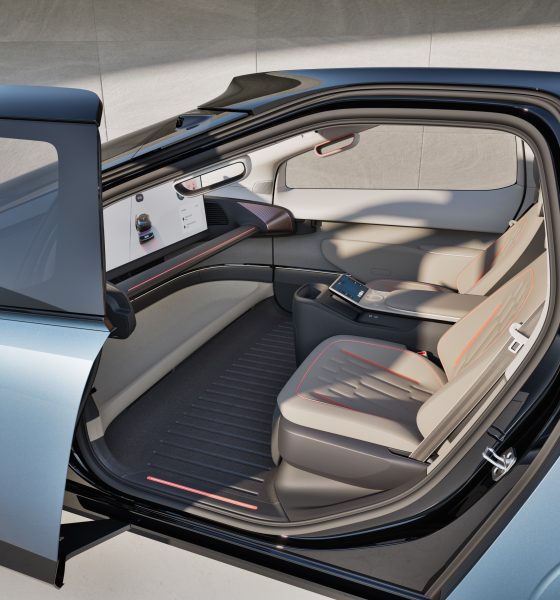Verne is the newest participant in the race to develop a fully autonomous, boundary-free EV robotaxi, and it comes at the hands of Rimac.
A sensation in the realm of EV supercars, Rimac is synonymous with ultra-luxurious electric vehicles that push the boundaries of performance, if you’re willing to pay the price.
Now, the company’s founder, Mate Rimac, and two of his closest colleagues from Rimac Group, both Marko Pejković and Adriano Mudri, have launched Verne, the company’s crack at an autonomous robotaxi that will be launched in Zagreb, Croatia, in 2026.
Mudri has been named Chief Design Officer at Verne, while Pejković takes over as CEO of the new venture. Its goal: built a fully autonomous EV, enable it as a mobility service platform, and build an adequate infrastructure to support it.
Fully Autonomous EV
Verne will launch a vehicle that is built upon a completely new platform that is designed around safety and comfort, two factors that the company feels are most important in the robotaxi experience.
Completely engineered from the ground up, Verne will develop an autonomous EV using Mobileye Drive, an autonomous platform.
Starting from scratch and building what it believes will be fully operational within two years, the platform is free of any compromises and disadvantages that would come from developing a groundbreaking vehicle type with scraps inspired by a vehicle designed for human driving.
Mobility Service Platform (MSP)
Tailored for driver-free pickup, passengers are the first thought in Verne’s initial development. Of course, this is no different than traditional ride-hailing services that exist today, but without a human controlling the wheel, things need to be different.
Before ordering a ride, the Verne app will allow users to completely personalize everything. From temperature to comfort to lighting to scent, those who request a ride from a Verne EV can choose everything.
Infrastructure
Verne will expand past Zagreb in the coming years, and each city where the company operates will be the home of the “Mothership,” where every vehicle is inspected, maintained, cleaned, and charged.
Verne’s first production facility for the new EV will be in Croatia. The cars will be deployed worldwide.
New Leadership
Mudri has huge expectations for Verne, which is named after Jules Verne, an author who is said to be “the man who invented the future”:
“Just as he used the theme of travel as the driving force in his storytelling, we use it as our inspiration in shaping a future filled with imaginative innovation and tangible achievement. His faith in the future and his spirit sparked the curiosity in generations of scientists and explorers. Making things that sometimes seem impossible, possible.”
Mate Rimac said the goal for Verne is to have more than just Point A to Point B transportation:
“The end result would be the best possible mobility experience for everyone. This means that every customer will have a better service than the best mobility service enjoyed by the very rich, through the service that is affordable for all. You will have a safe and reliable driver, a vehicle with more interior space and comfort than the best limousines today, and a service that will be tailored to your needs in every possible way.”
Robotaxi Design
Verne’s robotaxi vehicle will have two seats and an interior concept that “completely redefines” past narratives about interior space. Mudri said that 9 out of 10 rides through ride-hailing services are used by 1 or 2 people:
“Therefore, we can satisfy most of all trips with a two-seater and create unmatched interior space in a compact-sized vehicle. We completely redefined interior space. More space than a Rolls-Royce to relax and spend your time well.
It will also feature things like music and movies with an ultrawide screen and 17 speakers for enhanced audio.
As for the exterior, it will be sleek, with deeply integrated cameras, radars, short and long-distance-lidars, no windshield wipers, and no side-view mirrors:
Čestitamo Mati Rimcu i njegovom timu na izradi prototipa budućeg autonomnog električnog vozila, “Verne”! Ponosni smo na još jednu ?? inovaciju koja će mijenjati svijet. Podupiremo ulaganja koja povezuju digitalnu i zelenu tranziciju i ostvaruju ciljeve 5️⃣.industrijske revolucije. pic.twitter.com/3yK73MESr7
— Andrej Plenković (@AndrejPlenkovic) June 26, 2024
“This makes the aerodynamic performance more efficient and allows for easier cleaning. One typical element of an automobile we kept is the trunk. So you don’t need to worry if you‘re going to the airport with a lot of luggage or just finished a major grocery shopping.”
There’s a long way to go, a lot of competition, and so many variables that come into play with this new project.
I’d love to hear from you! If you have any comments, concerns, or questions, please email me at joey@teslarati.com. You can also reach me on Twitter @KlenderJoey, or if you have news tips, you can email us at tips@teslarati.com.

Elon Musk
Elon Musk and Tesla AI Director share insights after empty driver seat Robotaxi rides
The executives’ unoccupied tests hint at the rapid progress of Tesla’s unsupervised Robotaxi efforts.

Tesla CEO Elon Musk and AI Director Ashok Elluswamy celebrated Christmas Eve by sharing personal experiences with Robotaxi vehicles that had no safety monitor or occupant in the driver’s seat. Musk described the system’s “perfect driving” around Austin, while Elluswamy posted video from the back seat, calling it “an amazing experience.”
The executives’ unoccupied tests hint at the rapid progress of Tesla’s unsupervised Robotaxi efforts.
Elon and Ashok’s firsthand Robotaxi insights
Prior to Musk and the Tesla AI Director’s posts, sightings of unmanned Teslas navigating public roads were widely shared on social media. One such vehicle was spotted in Austin, Texas, which Elon Musk acknowleged by stating that “Testing is underway with no occupants in the car.”
Based on his Christmas Eve post, Musk seemed to have tested an unmanned Tesla himself. “A Tesla with no safety monitor in the car and me sitting in the passenger seat took me all around Austin on Sunday with perfect driving,” Musk wrote in his post.
Elluswamy responded with a 2-minute video showing himself in the rear of an unmanned Tesla. The video featured the vehicle’s empty front seats, as well as its smooth handling through real-world traffic. He captioned his video with the words, “It’s an amazing experience!”
Towards Unsupervised operations
During an xAI Hackathon earlier this month, Elon Musk mentioned that Tesla owed be removing Safety Monitors from its Robotaxis in Austin in just three weeks. “Unsupervised is pretty much solved at this point. So there will be Tesla Robotaxis operating in Austin with no one in them. Not even anyone in the passenger seat in about three weeks,” he said. Musk echoed similar estimates at the 2025 Annual Shareholder Meeting and the Q3 2025 earnings call.
Considering the insights that were posted Musk and Elluswamy, it does appear that Tesla is working hard towards operating its Robotaxis with no safety monitors. This is quite impressive considering that the service was launched just earlier this year.
Elon Musk
Starlink passes 9 million active customers just weeks after hitting 8 million
The milestone highlights the accelerating growth of Starlink, which has now been adding over 20,000 new users per day.

SpaceX’s Starlink satellite internet service has continued its rapid global expansion, surpassing 9 million active customers just weeks after crossing the 8 million mark.
The milestone highlights the accelerating growth of Starlink, which has now been adding over 20,000 new users per day.
9 million customers
In a post on X, SpaceX stated that Starlink now serves over 9 million active users across 155 countries, territories, and markets. The company reached 8 million customers in early November, meaning it added roughly 1 million subscribers in under seven weeks, or about 21,275 new users on average per day.
“Starlink is connecting more than 9M active customers with high-speed internet across 155 countries, territories, and many other markets,” Starlink wrote in a post on its official X account. SpaceX President Gwynne Shotwell also celebrated the milestone on X. “A huge thank you to all of our customers and congrats to the Starlink team for such an incredible product,” she wrote.
That growth rate reflects both rising demand for broadband in underserved regions and Starlink’s expanding satellite constellation, which now includes more than 9,000 low-Earth-orbit satellites designed to deliver high-speed, low-latency internet worldwide.
Starlink’s momentum
Starlink’s momentum has been building up. SpaceX reported 4.6 million Starlink customers in December 2024, followed by 7 million by August 2025, and 8 million customers in November. Independent data also suggests Starlink usage is rising sharply, with Cloudflare reporting that global web traffic from Starlink users more than doubled in 2025, as noted in an Insider report.
Starlink’s momentum is increasingly tied to SpaceX’s broader financial outlook. Elon Musk has said the satellite network is “by far” the company’s largest revenue driver, and reports suggest SpaceX may be positioning itself for an initial public offering as soon as next year, with valuations estimated as high as $1.5 trillion. Musk has also suggested in the past that Starlink could have its own IPO in the future.
News
NVIDIA Director of Robotics: Tesla FSD v14 is the first AI to pass the “Physical Turing Test”
After testing FSD v14, Fan stated that his experience with FSD felt magical at first, but it soon started to feel like a routine.

NVIDIA Director of Robotics Jim Fan has praised Tesla’s Full Self-Driving (Supervised) v14 as the first AI to pass what he described as a “Physical Turing Test.”
After testing FSD v14, Fan stated that his experience with FSD felt magical at first, but it soon started to feel like a routine. And just like smartphones today, removing it now would “actively hurt.”
Jim Fan’s hands-on FSD v14 impressions
Fan, a leading researcher in embodied AI who is currently solving Physical AI at NVIDIA and spearheading the company’s Project GR00T initiative, noted that he actually was late to the Tesla game. He was, however, one of the first to try out FSD v14.
“I was very late to own a Tesla but among the earliest to try out FSD v14. It’s perhaps the first time I experience an AI that passes the Physical Turing Test: after a long day at work, you press a button, lay back, and couldn’t tell if a neural net or a human drove you home,” Fan wrote in a post on X.
Fan added: “Despite knowing exactly how robot learning works, I still find it magical watching the steering wheel turn by itself. First it feels surreal, next it becomes routine. Then, like the smartphone, taking it away actively hurts. This is how humanity gets rewired and glued to god-like technologies.”
The Physical Turing Test
The original Turing Test was conceived by Alan Turing in 1950, and it was aimed at determining if a machine could exhibit behavior that is equivalent to or indistinguishable from a human. By focusing on text-based conversations, the original Turing Test set a high bar for natural language processing and machine learning.
This test has been passed by today’s large language models. However, the capability to converse in a humanlike manner is a completely different challenge from performing real-world problem-solving or physical interactions. Thus, Fan introduced the Physical Turing Test, which challenges AI systems to demonstrate intelligence through physical actions.
Based on Fan’s comments, Tesla has demonstrated these intelligent physical actions with FSD v14. Elon Musk agreed with the NVIDIA executive, stating in a post on X that with FSD v14, “you can sense the sentience maturing.” Musk also praised Tesla AI, calling it the best “real-world AI” today.










